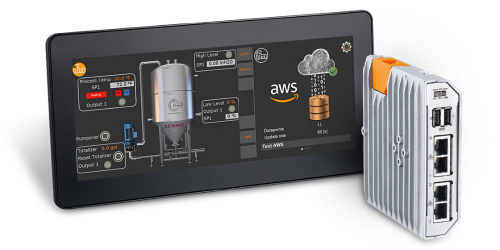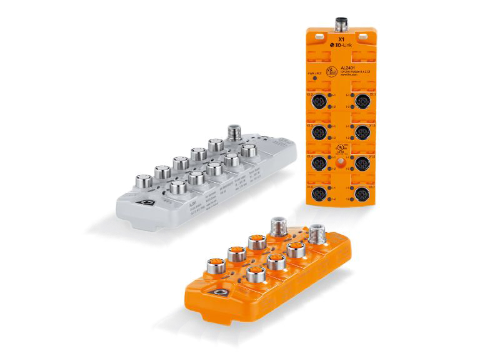Discover the IO-Link advantage
IO-Link is a worldwide open standard protocol that is used for communication between devices in industrial settings. It facilitates bidirectional data exchange between a master device, actuators, and sensors.
IO-Link is the foundational technology of the Industrial Internet of Things (IIoT). This digital communication network provides raw sensor values for more accurate data from your machines. It also eliminates the need to scale analog signals.
| Reduce the total cost and time of a machine build: | Save time during commissioning: | Improve your end user experience: | ||
|---|---|---|---|---|
|
|
|
Traditional point-to-point wiring
IO-Link controls system
Traditional control cabinet size
- Hundreds of terminal connections and wire routes are susceptible to error.
- Typically 25-30% extra space is built into the control cabinet for future expansion.
- Future expansion requires extensive knowledge to leverage existing cable runs.
Smaller control cabinet using IO-Link
- I/O is field mounted, so cabinet size is reduced.
- Estimated 35% reduction in controls cost.
- Estimated 60% reduction in commissioning time.
Discrete and analog signals
- ON/OFF and analog signals from devices are susceptible to noise interference.
- Digital to analog conversions degrade signal and accuracy from collection to final processing.
100% digital communication
- Ethernet communication between the IO-Link master and PLC provides a bidirectional digital data highway.
- No EMC interference or signal loss even with long cable runs.
- Pure digital communication reduces data transmission and conversion errors.
Traditional sensors
- If a sensor has multiple values, such as flow and temperature, each value requires its own wire for that output.
- Connection requires home run cables or direct connection, often with hundreds of wire terminations.
Unlock the power of IO-Link
- Most new sensor technology already offers IO-Link communication without increasing the cost of the sensor.
- An industry standard 3-wire cordset carries multiple process values, such as flow rate, temperature, history, and other diagnostics, over a single wire.
- Automatic device replacement transfers configuration parameters from one sensor to another in seconds and minimizes downtime in the event of a sensor failure.
The IO-Link communications protocol has grown tenfold over the last decade from 5 million installed nodes to more than 50 million installed nodes for a number of reasons.
Reduced complexity
Scalable technology from simple binary on/ff devices up to smart IO-Link enabled sensors provide complete process transparency that quickly integrates into existing controls architecture.
Reduced cost
Savings of approximately 50% per point on input cards without the need for analog PLC cards.
With ifm, there is often no impact on sensor cost because the communication is already available in most of our sensors.
Minimal changes
Replacing analog communication requires few changes to controls architecture. And, each device can be connected using standard 3-wire unshielded cabling.
Improved product quality
The 100% digital signal is more accurate and reliable than an analog signal. Processes are more repeatable. Predictive information from sensors provides continuous instrument verification.
Increased efficiency
Bidirectional communication between the process instruments and the controller allows for reduced cycle times for recipe changes.
Improve machine uptime
IO-Link enabled sensors minimize unplanned downtime to get machines up and running faster. The automatic device replacement feature automatically downloads parameters from an existing device onto a replacement device in seconds.
IO-Link communicates bidirectionally with sensors, actuators, and other devices connected to a master module using industry standard 3-wire cordsets. The master sends commands to the devices and the devices send digital process data to the master.
Since the process data is purely digital and there are no A/D conversion losses, the data is more accurate and reliable.
Most IO-Link enabled devices also transmit diagnostic data, such as run-time and error codes to aid in predictive maintenance and improved process control.
Vist the Technology page for more details on how IO-Link works.
IO-Link combines the best of all worlds with the functionality of analog signals and intelligence of Ethernet communication at the cost of binary ON/OFF points.
| Sensor communication | ||||
|---|---|---|---|---|
| Binary On/Off | Analog | IO-Link | Ethernet based | |
| Amount of data | 1 bit | 16 bits | 32 bytes | Many bytes |
| Sensor diagnostics | ||||
| Remote sensor parameter adjustment | ||||
| Automatic sensor parameter replacement | ||||
| Standard sensor cordsets | ||||
| Digital communication | ||||
| Complexity to integrate | ||||
| Cost | ||||
In the rapidly-evolving landscape of industrial technology and automation, ifm is committed to innovation, efficiency, and conserving resources. We’re dedicated to universal protocols and advancing interconnection between ecosystems.
ifm is a founding member of the IO-Link consortium. This group works with industry leaders to further the technology and integration, upholds quality standards, holds workshops, and more. The consortium has more than 250 members and counting.
We offer one of the largest selections of sensors and other IO-Link-compatible devices. Our broad offering allows you to implement a comprehensive digital communication system on all your machines and processes.

edgeGateways
The edgeGateways from ifm provide secure remote connection to your IT infrastructure for convenient data transfer to cloud platforms, such as ifm moneo Cloud, Microsoft Azure IoT Hub, or AWS IoT Core.

Controllers
ifm's HMI controllers are programmable graphic displays for controlling, parameterizing, and operating industrial machinery. One HMI controller can replace a PLC, HMI, and multiple software licenses. IO-Link field devices can be connected mechanically, versus labor-intensive wiring harnesses.

IO-Link masters
IO-Link masters provide solutions to acquire intelligent sensor data from IO-Link enabled sensors and actuators. The IO-Link master establishes the connection between one or several devices and the fieldbus system or higher level IIoT platforms.

IO-Link hub expansion modules
Machine control does not always require data acquisition. In many cases, simple digital and analog I/O are still required. A hybrid approach is often the best control solution.
The configurable IO-Link modules allow connection of conventional digital and analog sensor and digital actuators via IO-Link.

Sensors and devices
ifm offers one of the largest selections of sensors and other IO-Link-compatible devices. These allow users to install flexible controls systems for their manufacturing operations.
ifm also offers signal conversion devices to transform analog, binary, or RTD signals into IO-Link, preparing your control system for IIoT.
Starter kits are an ideal choice for a fast proof-of-concept IO-Link project. Our kits include all products you need to begin your testing.